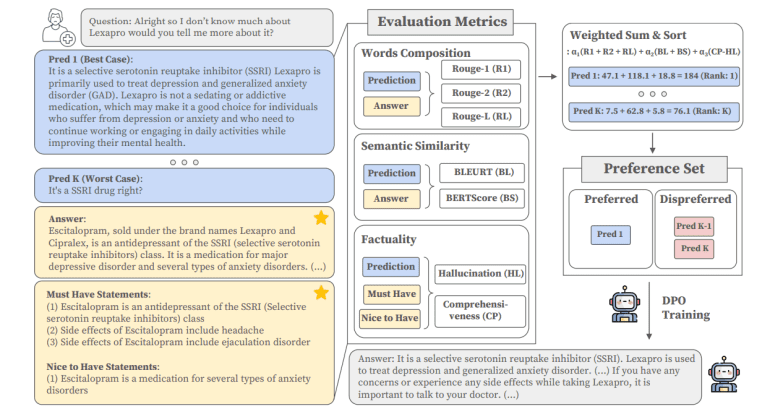- OLAPH framework revolutionizes factual accuracy in medical AI by refining LLM-generated responses.
- MedLFQA dataset facilitates automated assessment of factual accuracy in biomedical AI.
- Two comprehensive assessment statements gauge the veracity of medical claims by LLMs.
- OLAPH employs iterative learning and automated evaluation to optimize LLM responses.
- Empirical evidence showcases OLAPH-equipped LLMs matching domain experts in factual accuracy.
Main AI News:
In the dynamic landscape of healthcare, the integration of Large Language Models (LLMs) is heralding a new era of possibilities. With their expanding capabilities, LLMs are not merely tools but invaluable assets, poised to transform clinical and medical practices. From dispensing medical information to facilitating patient consultations, these models are redefining the contours of healthcare delivery.
A cornerstone of LLMs’ utility in the medical domain lies in their adeptness at generating comprehensive, long-form textual responses. In an era where accuracy is paramount, particularly in medical contexts where misinformation can be perilous, LLMs emerge as reliable allies. However, ensuring the fidelity of information dispensed by these models necessitates a robust evaluation mechanism.
Enter OLAPH (Optimizing Large language models’ Answers with Preferences of reducing Hallucination), a groundbreaking framework designed to augment the factual accuracy of LLM-generated responses. Spearheaded by a team of visionary researchers, OLAPH embodies a paradigm shift in how we perceive and harness AI in healthcare.
At its core, OLAPH operates through an iterative process of automated assessment and learning. By prioritizing responses with superior factual and assessment metrics scores, OLAPH fine-tunes LLMs to deliver responses aligned with verifiable truths. This iterative refinement not only mitigates the risk of misinformation but also enhances the reliability of LLM-generated content.
The efficacy of OLAPH is underscored by empirical evidence, with significant enhancements in factual accuracy observed across LLMs trained using this framework. Notably, even when subjected to rigorous evaluation measures beyond the training scope, LLMs imbued with OLAPH exhibit performance akin to seasoned medical professionals.
Key Contributions:
- MedLFQA: Redefining Benchmarking in Biomedical AI The release of MedLFQA marks a pivotal milestone in automated assessment within the biomedical domain. This meticulously curated dataset empowers researchers to gauge the factual accuracy of LLM-generated responses with unprecedented granularity.
- Evaluating Medical Veracity: Setting New Standards In response to the burgeoning need for robust evaluation metrics, the team has devised comprehensive assessment statements. These statements serve as litmus tests, offering insights into the veracity of medical claims propagated by LLMs.
- OLAPH Framework: A Catalyst for Factual Precision OLAPH represents a quantum leap in optimizing LLM responses through iterative refinement. By marrying automated evaluation with iterative learning, OLAPH ensures that LLM-generated content adheres to the highest standards of factual accuracy.
- Benchmarking Factual Accuracy: Bridging the Divide Through empirical validation, it has been unequivocally demonstrated that OLAPH-equipped LLMs, boasting 7 billion parameters, exhibit factual accuracy on par with domain experts. This convergence heralds a new dawn in AI-enabled healthcare delivery.
Conclusion:
The introduction of the OLAPH framework marks a significant advancement in the field of medical AI, enhancing the accuracy and reliability of LLM-generated content. With the capability to rival domain experts in factual precision, OLAPH-equipped LLMs have the potential to revolutionize healthcare delivery, offering unparalleled insights and support to medical professionals. This breakthrough underscores the growing importance of ethical AI integration in healthcare, paving the way for transformative innovations and enhanced patient care.

